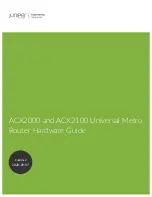
64
Type-2 routes to the same destination have the same cost, OSPF takes the cost from the router to the ASBR
into consideration to determine the best route.
Route calculation
OSPF computes routes in an area as follows:
•
Each router generates LSAs based on the network topology around itself, and sends them to other
routers in update packets.
•
Each OSPF router collects LSAs from other routers to compose an LSDB. An LSA describes the
network topology around a router, and the LSDB describes the entire network topology of the area.
•
Each router transforms the LSDB to a weighted directed graph that shows the topology of the area.
All the routers within the area have the same graph.
•
Each router uses the SPF algorithm to compute a shortest path tree that shows the routes to the nodes
in the area. The router itself is the root of the tree.
OSPF network types
OSPF classifies networks into the following types, depending on different link layer protocols:
•
Broadcast
—If the link layer protocol is Ethernet or FDDI, OSPF considers the network type as
broadcast by default. On a broadcast network, hello, LSU, and LSAck packets are multicast to
224.0.0.5 that identifies all OSPF routers or to 224.0.0.6 that identifies the DR; DD packets and LSR
packets are unicast.
•
NBMA
—If the link layer protocol is Frame Relay, ATM, or X.25, OSPF considers the network type
as NBMA by default. OSPF packets are unicast on a NBMA network.
•
P2MP
—No link is P2MP type by default. P2MP must be a conversion from other network types such
as NBMA. On a P2MP network, OSPF packets are multicast to 224.0.0.5.
•
P2P
—If the link layer protocol is PPP or HDLC, OSPF considers the network type as P2P. On a P2P
network, OSPF packets are multicast to 224.0.0.5.
The following are the differences between NBMA and P2MP networks:
•
NBMA networks are fully meshed. P2MP networks are not required to be fully meshed.
•
NBMA networks require DR and BDR election. P2MP networks do not have DR or BDR.
•
On a NBMA network, OSPF packets are unicast, and neighbors are manually configured. On a
P2MP network, OSPF packets are multicast by default, and you can configure OSPF to unicast
protocol packets.
DR and BDR
DR and BDR mechanism
On a broadcast or NBMA network, any two routers must establish an adjacency to exchange routing
information with each other. If n routers are present on the network, n(n-1)/2 adjacencies are established.
Any topology change on the network results in an increase in traffic for route synchronization, consuming
many system and bandwidth resources.
The DR and BDR mechanisms can solve this problem.















































